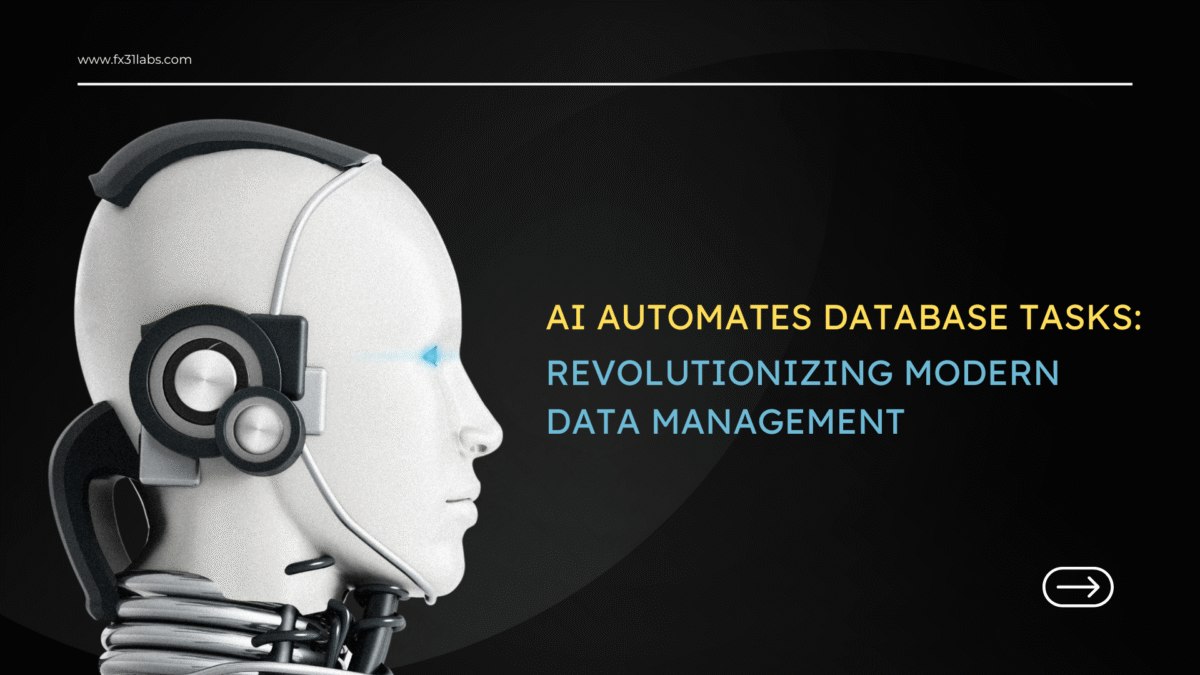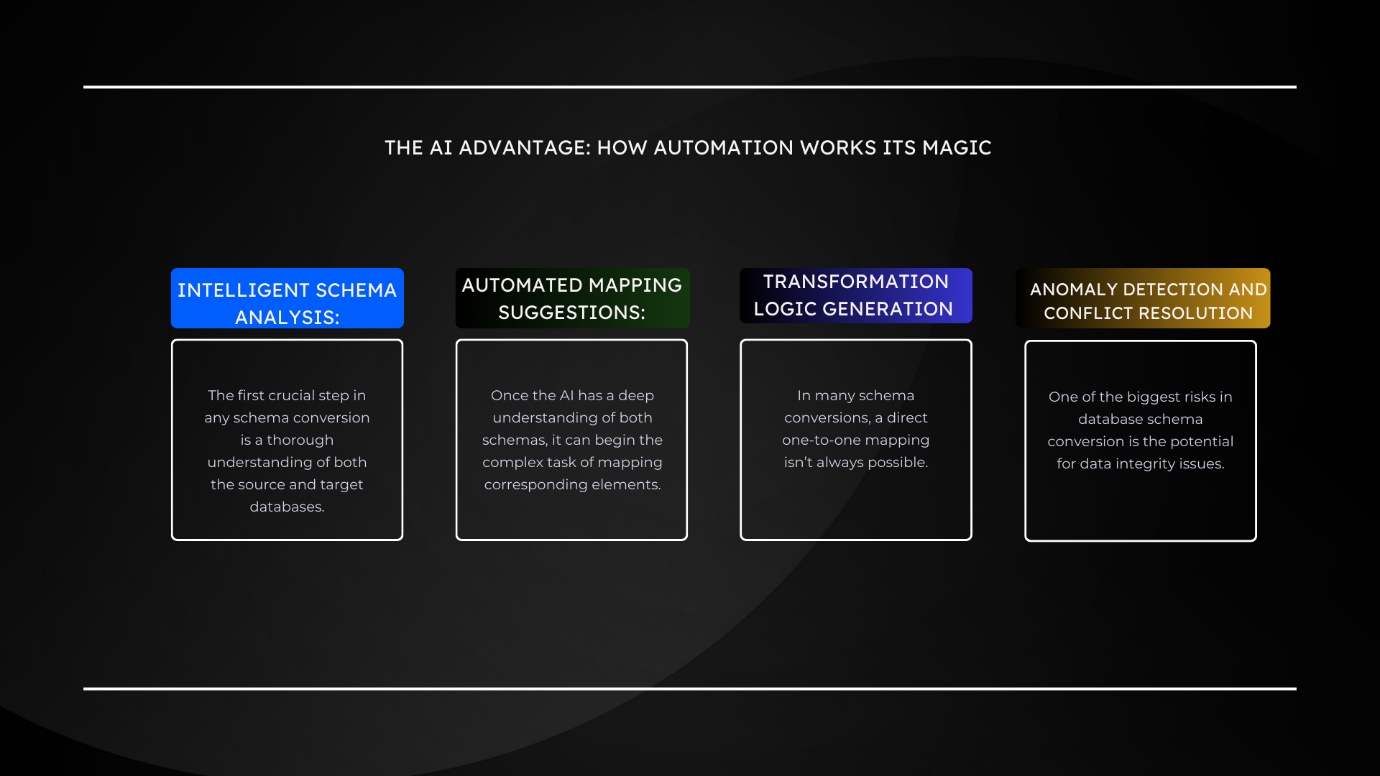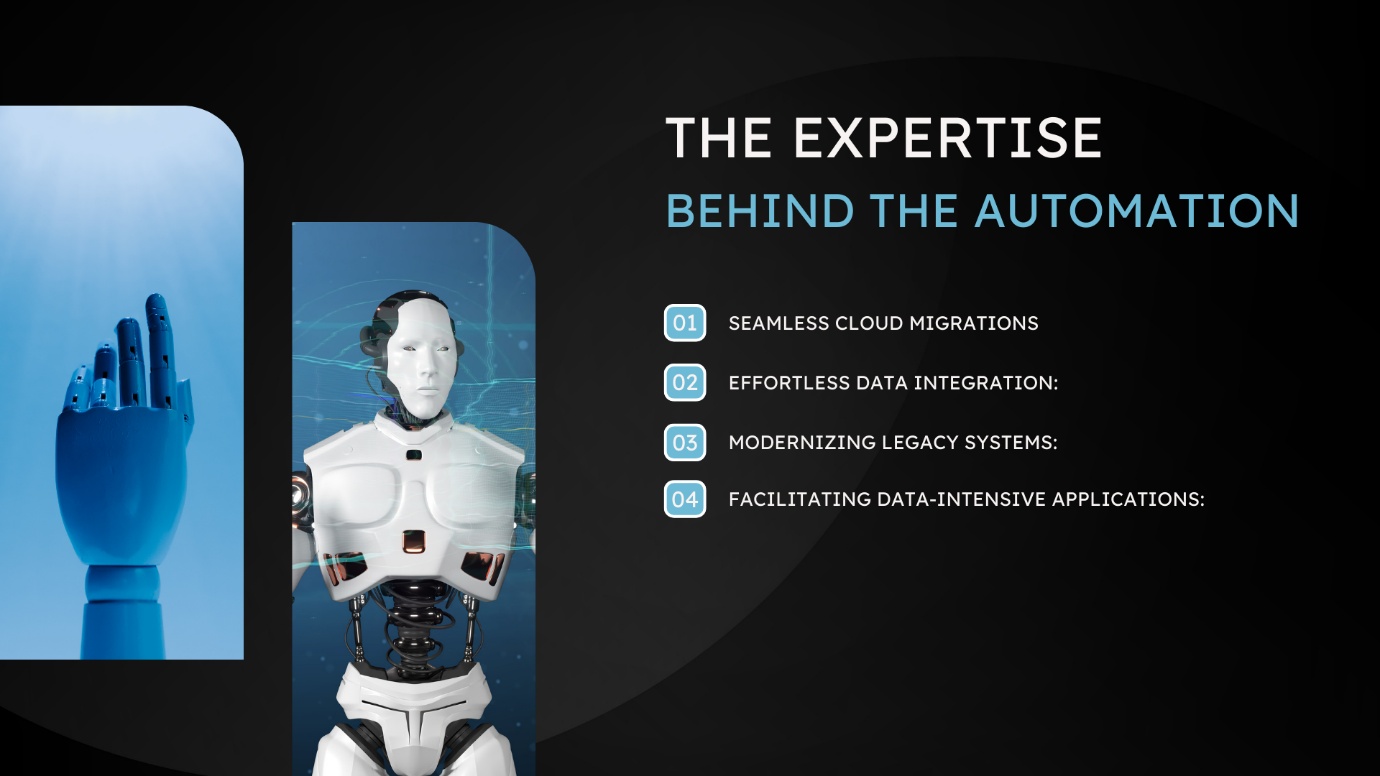AI Automates Database Tasks: Revolutionizing Modern Data Management

Introduction: The Database Schema Conversion Conundrum
AI automates database operations like never before, transforming the way organizations manage data migration, schema conversion, indexing, and optimization. This shift toward automation is eliminating manual errors, speeding up processes, and enabling smart, scalable architectures.
The digital landscape is in constant flux. Businesses evolve, technologies advance, and the need to adapt and modernize software systems becomes a recurring imperative. At the heart of many such transformations lies a seemingly mundane yet often daunting task: database schema conversion. For developers, the mere mention can conjure images of late nights, meticulous manual mapping, and the ever-present anxiety of data loss. It’s a process often viewed as a necessary evil – a time-consuming and error-prone hurdle that stands between the current state and the desired future.
Imagine this: your company is migrating its entire application suite to a cutting-edge cloud platform. The promise of scalability and enhanced performance is tantalizing, but lurking beneath the surface is the intricate dance of moving your vast database – with its myriad tables, intricate relationships, and diverse data types – from its legacy home to the new environment. The schemas, the very blueprints of your data organization, are likely different, requiring a painstaking process of mapping fields, transforming data types, and ensuring data integrity. One wrong step, one overlooked detail, and the entire migration could be jeopardized, leading to costly errors and significant downtime.
Or perhaps your organization has recently acquired another company, bringing with it a wealth of valuable data stored in a completely different database system. Integrating this data into your existing infrastructure is crucial for gaining a holistic view of your operations and unlocking new insights. However, the disparate database schemas act as formidable barriers, demanding a complex and potentially disruptive conversion process.
These scenarios are not isolated incidents. They represent the everyday realities faced by development teams across industries. Database schema conversion, while essential for progress, has traditionally been a labor-intensive undertaking, demanding meticulous attention to detail and a deep understanding of both the source and target database systems. It’s a task where human error can easily creep in, leading to data inconsistencies, application failures, and significant setbacks.
But what if there was a way to alleviate this burden? What if the tedious manual mapping and the inherent risks could be minimized, allowing developers to focus on more strategic and innovative aspects of their work? The answer, increasingly, lies in the transformative power of Artificial Intelligence.
How AI Automates Database Operations

Artificial Intelligence is no longer a futuristic fantasy; it’s a tangible force reshaping various aspects of software development, and database schema conversion is no exception. At its core, AI-powered automation of this process leverages sophisticated algorithms, primarily within the realms of Machine Learning and potentially drawing upon concepts of Generative AI, to analyze, understand, and ultimately translate database schemas with remarkable efficiency and accuracy.
Imagine an AI system capable of “reading” and comprehending the intricate language of database structures. Machine Learning algorithms are trained on vast datasets of database schemas and conversion patterns, enabling them to identify recurring structures, understand data type equivalences, and recognize the relationships between different tables and fields. This learning allows the AI to go beyond simple keyword matching and develop a semantic understanding of the underlying data organization.
Here’s a closer look at the key automated capabilities that AI brings to the table:
- Intelligent Schema Analysis: The first crucial step in any schema conversion is a thorough understanding of both the source and target databases. AI excels at this. By ingesting the metadata of both schemas, AI algorithms can automatically dissect their structures, identifying tables, columns, data types, constraints (like primary and foreign keys), and indexes. This intelligent analysis goes beyond simply listing the components; it involves understanding the purpose and relationships within each schema. For instance, an AI might recognize that a “customer_id” field in one database serves the same logical purpose as a “cust_number” field in another, even if their names are different. This level of semantic understanding is a significant leap beyond traditional rule-based approaches.
- Automated Mapping Suggestions: Once the AI has a deep understanding of both schemas, it can begin the complex task of mapping corresponding elements. Leveraging its training data and analytical capabilities, the AI can suggest potential mappings between tables and columns. In more advanced scenarios, it can even automatically generate these mappings with a high degree of accuracy. The AI considers not only the names of the elements but also their data types, constraints, and the relationships they hold within their respective schemas. This drastically reduces the manual effort involved in identifying and linking hundreds or even thousands of fields.
- Transformation Logic Generation (if applicable): In many schema conversions, a direct one-to-one mapping isn’t always possible. Data might need to be transformed during the migration process – for example, concatenating first and last names into a single “full_name” field, or converting date formats. AI can learn these transformation patterns and, in some cases, even generate the necessary code or scripts to perform these transformations automatically. This significantly streamlines the data migration phase, reducing the need for developers to write and test complex data transformation logic.
- Anomaly Detection and Conflict Resolution: One of the biggest risks in database schema conversion is the potential for data integrity issues. AI can play a crucial role in mitigating this risk by identifying potential anomalies and conflicts between the source and target schemas. For example, it might flag instances where a required field in the target schema doesn’t have a corresponding field in the source, or where data type mismatches could lead to data loss or truncation. The AI can then suggest potential resolutions, such as creating default values or implementing specific data transformation rules.
- Accelerated Conversion Execution: The cumulative effect of these automated capabilities is a significant reduction in the time required for the entire database schema conversion process. Tasks that previously took days or even weeks of manual effort can be accomplished in a fraction of the time with AI assistance. This acceleration not only frees up valuable developer resources but also minimizes downtime and allows for faster deployment of new applications or integration of new data sources.
Benefits When AI Automates Database Management
The adoption of AI-powered tools for database schema conversion translates into a multitude of tangible benefits for development teams and the organizations they serve:
- Unprecedented Efficiency Gains: The most immediate and significant benefit is the dramatic increase in efficiency. AI can automate the most time-consuming and repetitive aspects of schema conversion, freeing up developers from the tedious work of manual mapping and allowing them to focus on more complex and strategic tasks. This accelerated pace can significantly shorten project timelines and lead to faster time-to-market for new applications and features.
- Enhanced Accuracy and Reduced Errors: Human error is an inevitable factor in manual processes. The intricate nature of database schemas, with their numerous tables and fields, makes them particularly susceptible to mistakes during manual conversion. AI, on the other hand, operates with consistent precision, meticulously analyzing and mapping schemas based on its learned patterns and algorithms. This significantly reduces the risk of data inconsistencies, data loss, and the costly rework associated with manual errors.
- Significant Cost Reduction: The efficiency gains and reduced error rates directly translate into significant cost savings. By automating the schema conversion process, organizations can reduce the number of developer hours required for the task, lowering labor costs. Furthermore, minimizing errors prevents costly rework and potential application downtime, further contributing to the bottom line.
- Streamlined Migration and Integration Processes: AI-powered tools make database migrations and integrations smoother and less disruptive. The automated analysis and mapping capabilities minimize the complexities involved in moving or merging data between disparate systems. This leads to faster and more reliable transitions, reducing the impact on ongoing operations.
- Empowering Developers for Innovation: By taking over the burden of manual schema conversion, AI empowers developers to focus on more creative and innovative aspects of their work. Instead of spending countless hours on a tedious and error-prone task, they can dedicate their expertise to designing better applications, developing new features, and solving more complex technical challenges. This shift in focus can lead to increased developer satisfaction and a more innovative development culture.
The Expertise Behind the Automation

While the power of AI in automating database schema conversion is undeniable, the effective implementation and utilization of such technologies often require specialized expertise. Companies at the forefront of leveraging advanced technologies like AI in software development play a crucial role in building and applying these intelligent solutions.
Organizations with a deep understanding of both database systems and the intricacies of Artificial Intelligence are well-positioned to develop and deploy AI-powered tools that can truly revolutionize the schema conversion process. Their teams, comprised of experienced software engineers and AI/Machine Learning specialists, possess the knowledge and skills necessary to build robust and reliable automation solutions.
These experts understand the nuances of different database types, the complexities of data modeling, and the power of AI algorithms to learn and adapt. They can develop intelligent systems that not only automate the mapping process but also provide valuable insights and recommendations, ensuring a smooth and accurate transition.
Furthermore, for businesses considering software development outsourcing, partnering with a provider that has a strong focus on AI-driven development can offer significant advantages. These providers can bring their expertise and pre-built AI tools to the table, streamlining the database migration or integration process and delivering faster, more cost-effective results. Their teams are equipped to handle the complexities of schema conversion, allowing the client’s internal teams to focus on their core business objectives.
Real-World Use Cases Where AI Automates Database Systems
The benefits of AI-powered schema conversion are applicable across a wide range of scenarios:
- Seamless Cloud Migrations: When migrating large and complex on-premise databases to cloud environments, AI can automate the often-challenging task of adapting the schema to the cloud platform’s specific requirements, ensuring a smooth and efficient transition.
- Effortless Data Integration: Integrating data from disparate databases following mergers, acquisitions, or the adoption of new SaaS applications becomes significantly easier with AI, which can intelligently map and transform data between the different systems.
- Modernizing Legacy Systems: Updating and modernizing outdated database systems often involves significant schema changes. AI can streamline this process, minimizing disruption and ensuring data integrity during the transition to a more modern and efficient database structure.
- Facilitating Data-Intensive Applications: Developing applications that rely on real-time data processing often requires optimized database schemas. AI can assist in designing and implementing these schemas, ensuring efficient data storage and retrieval.
Conclusion: Embracing the Intelligent Future of Database Management
Database schema conversion, once a dreaded and time-consuming task, is undergoing a significant transformation thanks to the power of Artificial Intelligence. AI-driven automation offers a path towards greater efficiency, accuracy, and cost-effectiveness in managing and evolving our data infrastructure. By intelligently analyzing schemas, suggesting mappings, and even generating transformation logic, AI is alleviating the burden on development teams and allowing them to focus on more strategic and innovative endeavors.
As the digital landscape continues to evolve at a rapid pace, the ability to seamlessly migrate and integrate data will become increasingly critical. Embracing AI-powered solutions for database schema conversion is not just a technological advancement; it’s a strategic imperative for organizations looking to remain agile, competitive, and focused on innovation. By leveraging the intelligence of AI, we can move towards a future where even the most complex database transformations can be achieved without breaking a sweat, unlocking the true potential of our data and empowering developers to build the next generation of groundbreaking applications.
At FX31 Labs, we specialize in building AI-driven automation solutions that modernize legacy databases, optimize performance, and future-proof your data infrastructure.
👉 Looking to transform your database operations with AI?
Contact FX31 Labs today to explore how our custom AI automation services can help you reduce costs, increase efficiency, and unlock new possibilities.
